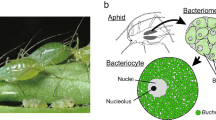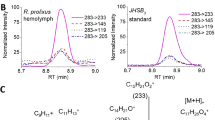Abstract
WHEN larvae of Aphis craccivora Koch become parasitized by the hymenopterous parasite Aphidius platensis Brèthes, they show a retention of juvenile characters (metathetely) in their subsequent instars1. If the parasite's eggs are deposited in 1st instar larvae, in addition to developing metathetely, the larvae show some prothetely—premature development of adult characters—when they moult into the 4th instar, and they never become adults, although they are not finally killed by the parasite until one or two days after they would normally have moulted into the adult stage1.
This is a preview of subscription content, access via your institution
Access options
Subscribe to this journal
Receive 51 print issues and online access
$199.00 per year
only $3.90 per issue
Buy this article
- Purchase on Springer Link
- Instant access to full article PDF
Prices may be subject to local taxes which are calculated during checkout
Similar content being viewed by others
References
Johnson, B., Entomologia Exp. Appl., 2, 82 (1959).
Van der Kloot, W., Ann. Rev. Physiol., 24, 491 (1962).
Johnson, B., J. Insect Physiol., 9, 727 (1963).
Bodenstein, D., Proc. 9th Int. Congr. Entomol., 2, 58 (1951). Wigglesworth, V. B., J. Exp. Biol., 29, 561 (1952); 32, 485 (1955).
Author information
Authors and Affiliations
Rights and permissions
About this article
Cite this article
JOHNSON, B. Premature Breakdown of the Prothoracic Glands in Parasitized Aphids. Nature 206, 958–959 (1965). https://doi.org/10.1038/206958a0
Issue Date:
DOI: https://doi.org/10.1038/206958a0
This article is cited by
-
Fine structure and function of the prosomal glands of the two-spotted spider mite, Tetranychus urticae (Acari, Tetranychidae)
Cell And Tissue Research (1981)
-
Die Ursachen der geschlechtlichen Gr��endifferenzen bei Aphelinus asychis Walker (Hym., Aphelinidae)
Zeitschrift f�r Parasitenkunde (1969)
Comments
By submitting a comment you agree to abide by our Terms and Community Guidelines. If you find something abusive or that does not comply with our terms or guidelines please flag it as inappropriate.



